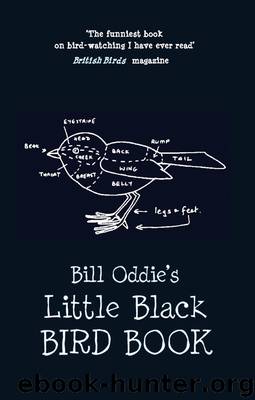Bill Oddie's Little Black Bird Book by Bill Oddie

Author:Bill Oddie
Language: eng
Format: epub
ISBN: 9781910232200
Publisher: Pavilion Books
Published: 2014-12-01T16:00:00+00:00
You look up and the bird has flown away. So try to strike a happy balance between looking at the bird and accurately writing down what you see. It’s amazing how difficult it can be to make accurate field notes. For a kick off, it’s often surprisingly difficult to even write. ‘January 12th north east wind’ – probably freezing cold. Either your fingers are too numb to hold your pencil, or you are wearing big woolly mittens that reduce your hands to paws. And if you suspect a rarity you get over excited and your handwriting goes to pot! That’s one of my problems. I have pages of field notes that are totally unreadable – it isn’t my own shorthand or hieroglyphics – it’s just scribble! I’ve probably lost lots of potential ticks because I couldn’t decipher my own notes.
Doing quick field sketches of the bird can be very useful indeed but under pressure can be depressingly inaccurate, especially if you are looking at the bird, and not at the drawing. It becomes ‘pin the tail on the warbler’. When you look down, it doesn’t even look like a bird! I used to draw blank silhouette outlines of birds in my book, ready to be filled in with the relevant details. The flaw is that obviously you can’t have a book full of silhouettes of every single bird family. It was OK as far as it went. I’d end up with a carefullylabelled silhouette of a bunting, with all the colour and markings well recorded, which was fine, as long as I remembered the note: ‘P.S. This was actually a duck’. The basic shape of whatever you are seeing is one of the first things you note down. With any luck, it shouldn’t be too problematic. At least you should be able to figure out whether you are watching a warbler or an eagle, or at least whether it was a big bird or a little bird. Actually, knowing to what family the bird belongs can present problems, and only experience can overcome it. As I shall later reveal, all sorts of abuses and misidentification relate to lack of accuracy about what kind of bird is in question. But for the moment, let’s concern ourselves with making a description of what colour or colours the bird is, and which different bits of the bird are of different colours.
Which brings us to an understanding of the bird’s anatomy. As with the human anatomy, you can be colloquial, or scientific, or very vague. So, with a man, you might refer to his head, his cranium, or the ‘top bit’, and it’s just the same with birds. Here are two sets of field notes:
Crown – dark irridescent greenish black. Neck and mantle: dark, irridescent, with flecks of yellow, white and pale buff. Lesser coverts: dark green with pale buffish white tips. Median coverts with dark centres and pale tips, and greater coverts similar. AU rémiges paie on outer webs, purple tinges on primaries and secondaries and yellower on tertials.
Download
This site does not store any files on its server. We only index and link to content provided by other sites. Please contact the content providers to delete copyright contents if any and email us, we'll remove relevant links or contents immediately.
The Lonely City by Olivia Laing(4750)
Animal Frequency by Melissa Alvarez(4395)
All Creatures Great and Small by James Herriot(4232)
Walking by Henry David Thoreau(3893)
Exit West by Mohsin Hamid(3777)
Origin Story: A Big History of Everything by David Christian(3648)
COSMOS by Carl Sagan(3554)
How to Read Water: Clues and Patterns from Puddles to the Sea (Natural Navigation) by Tristan Gooley(3406)
Hedgerow by John Wright(3275)
The Inner Life of Animals by Peter Wohlleben(3259)
How to Read Nature by Tristan Gooley(3249)
How to Do Nothing by Jenny Odell(3232)
Project Animal Farm: An Accidental Journey into the Secret World of Farming and the Truth About Our Food by Sonia Faruqi(3177)
Origin Story by David Christian(3147)
Water by Ian Miller(3127)
A Forest Journey by John Perlin(3027)
The Plant Messiah by Carlos Magdalena(2883)
A Wilder Time by William E. Glassley(2818)
Forests: A Very Short Introduction by Jaboury Ghazoul(2790)
